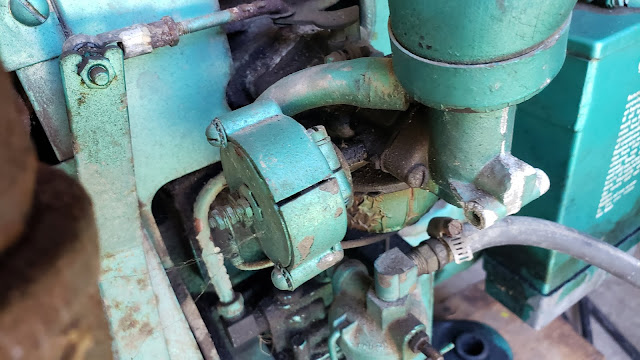Here's one:
And here's the other:
The top photo is a 205AJ-1P. It is a purchase my dad made sometime in the 1970s to use at our cabin on Marrowstone Island. He got it at a phone company auction (he worked for Pacific NW Bell), so he probably paid fifty bucks for it (he actually bought two and sold one). He rebuilt the motor and painted it white. I'm not sure why he chose that color but I'm guessing it's what he had laying around. It was a welcome addition to run lights (instead of Coleman lanterns) and other small things at the cabin. It runs at 3600 RPM, so isn't very quiet.
It hadn't been run in a number of years (my brother used it in the 90s until he got a 120/240 unit and I probably started it once when I got it from him), but I hooked it up to a gas can and it fired up on the 5th or 6th pull. And it ran like a top, just like I remember it from way back when. I put a load on it and it worked perfectly. It is missing it's specification tag, so I have no idea how old it is. I'm guessing 50s or 60s. It is built like a tank. A digital copy of an Onan brochure I have pegs the weight at 139 pounds.
This tag says the generator was put into service on August 22, 1969. This date jives with the build date indicated in the serial number of "0569", May 1969.
As I found out when I first acquired the generator, the starter solenoid in the upper right of the photo below is wrong for this application. This solenoid's internal coil is internally grounded to the mounting bracket, and applying 12 volts to the small terminal on top energizes the solenoid. A proper starter solenoid for this generator has one end of the coil connected internally to the large 12 volt terminal, and grounding the small terminal would then energize the coil.
Below is the spec tag, 2500 watts at 1800 RPM. It's much quieter than my other Onan generator. It's also quite a bit heavier, weighing in at a portly 240 pounds.
Being it's for an RV, it has the Vacu-Flo cooling, which sucks air across the engine cooling fins and out the duct, rather than blowing cooling air across the engine fins.
The photo below shows the electric choke on the carburetor.
When I dragged this generator out of its hiding place this week, I took hold of the flywheel and spun it over. Hmm, no compression.... So off came the carburetor, fuel pump, and tappet cover.
This is what I found, a stuck exhaust lifter.
A little gentle prying got the lifter unstuck. Once back together, the generator started up fine, other than me having to jury-rig the starter and the run/stop solenoids.
A couple days ago it was time to delve into the issues this generator was having. At first I hadn't realized the run/stop solenoid was broken, so I worked on the starter solenoid. I had an old Omron timer/solenoid laying around and wired it up so it would send a +12 volt signal to the starter solenoid when I gave the Omron timer a ground signal from the generator start switch. It worked fine but was a little on the kludgy side. It was also then that I realized the run/stop solenoid was not working.
I figured I may as well just bite the bullet and buy a new run/stop solenoid, and while I was at it I'd also replace the starter solenoid as I didn't like the kludgy Omron timer in the control box. So out came the offending solenoids.
The next photo below shows the two new solenoids in place, the starter solenoid on the lower left, and the black run/stop solenoid cube next to it that was soldered to the original solenoid leads. The generator now starts and stops with the two switches on the generator front panel.
One thing I read online was that the run/stop solenoid needed to be 6 volts, as it is connected to a resistor on the 12 volt line coming from the generator. The generator does have a 12 volt battery charge circuit but the run/stop solenoid only sees 6 volts. Good thing I read the 6 volt thing online, otherwise I would have bought a 12 volt solenoid and it probably would not have worked. Once I got the generator running again, I measured the voltage going to the solenoid, and sure enough, it was somewhere around 5.6 or 5.8 volts.
I guess the answer to my question posed in the title is, you can never have too many generators. Just don't ask me what my plans are for these two ancient door stops.


















No comments:
Post a Comment